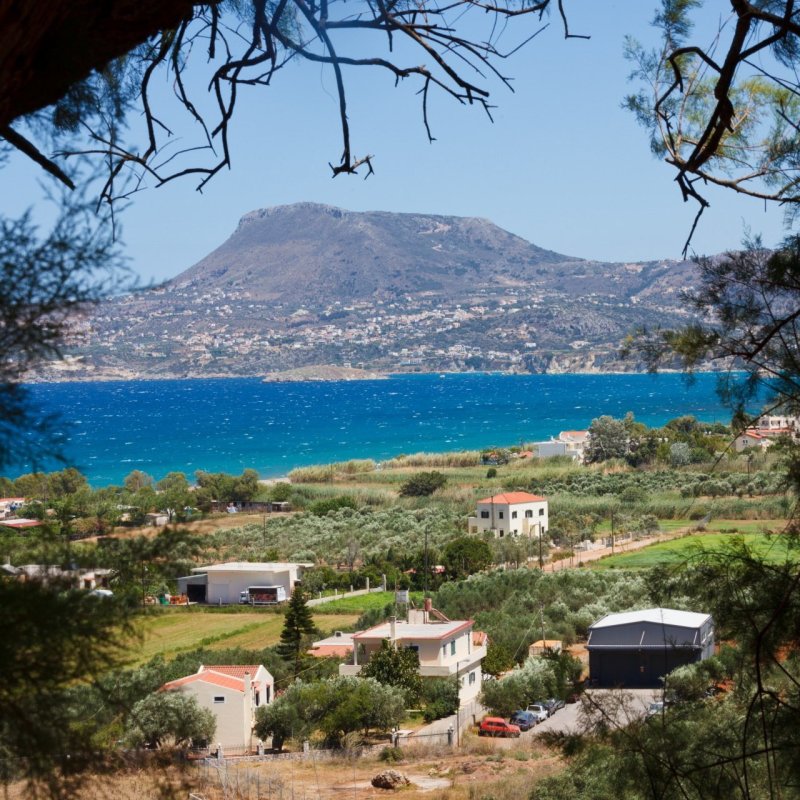
Belkis Gaeta / Pixy.org (CC0)
Located in the southern part of the Aegean Sea, Crete is the largest of the Greek islands. The Minoans occupied Crete from 2700 to 1420 B.C., and many other civilizations followed, making the island a fantastic destination for history buffs. Mountains, valleys, rivers, and beaches provide a great variety of nature experiences for travelers of all ages. While some of the highest mountains are covered with snow in the winter, the southern part of the island has a milder climate and nearly year-round sunshine.
Videos by TravelAwaits
Crete has two international airports — one in Heraklion and one in Chania — and is very well connected to the rest of Greece by ferries, mostly to Athens on the mainland and to other major islands.
To enjoy the following unique experiences, plan for at least two days on Crete. Driving in Crete can be hazardous, so you might prefer to take one of the island’s many guided tours.

1. Enjoy Greek Hospitality At The Mourtzanakis Residence
If you follow my advice and stay for at least two days, consider staying at the Mourtzanakis Residence in Achlada, about half an hour north of Heraklion. You can get there either by bus or by taxi, or you can ask to be picked up from the airport. It’s worth the effort, since you won’t be more comfortable or feel more welcome anywhere else!
This resort was dedicated to sustainability long before it became fashionable. You can stay either in one of the cozy villas or in the main building. From the minute you arrive, you’ll feel integrated and very welcome. All meals are taken at a long table in the dining room together with the owners and the other guests, many of whom come year after year from all over the world. Only local foods are used, and many are grown in the residence’s gardens and fields. Sadly, the owner’s wife, who was the soul of the place, recently passed away, but her secret recipes are still adhered to.
Yoga and walking tours are available, and the staff will happily help you plan trips to other places on the island.
2. Visit The Birthplace Of El Greco
Domenikos Theotokopoulos, better known as El Greco, was born in 1542 in Fodele, not far from Achlada. It’s a romantic little village in the midst of orange and lemon trees and olive groves and divided by a tiny river. Follow the signs to visit the birthplace of the great painter, who only achieved fame after moving to Toledo, Spain. Copies of his works are displayed in lightboxes in the tiny stone house.
Afterward, have a coffee in the marketplace under the gnarled, ancient trees and visit the nearby Byzantine church with its beautiful interior frescoes.

3. Explore The Mighty Koules Fortress
One of the first things you’ll see as you approach Heraklion is the Koules Fortress, a famous landmark with a violent past. The Venetians ruled Crete for four centuries and built a fortress around the harbor in the 13th century. It was destroyed by an earthquake, rebuilt, and reached its final form in 1540. The breakwater that supports the lower platform was constructed by sinking old ships loaded with stones. After a 21-year siege, the Ottomans expelled the Venetians and added to the castle.
The structure now has two stories, two parts, and a total of 26 rooms, all of which are open to the public. These once served as living quarters, storerooms, and sometimes, as prisons.
4. Be Charmed By Heraklion’s Old Town
Discovering the charm of Heraklion takes a bit of effort and a good amount of walking. It’s Greece’s fifth-largest city, and traffic, noise, dust, and modern buildings come with the territory. However, much has changed in recent years, beginning with the conversion of many zones into pedestrian areas to make sightseeing easier and more enjoyable. The 25th of August Street is a prime example.
Take the recently restored underground gate through the city walls in Eleftheria Square and tour the medieval old town. Admire the Venetian Loggia, built in 1628, which is now the town hall and considered the most elegant Venetian building on Crete.
An impressive sample of the many groups that have ruled Crete can be found at Agios Titos. Originally a Byzantine building, the Venetians rebuilt it in the 16th century. It was then turned into a mosque by the Ottomans and became a Greek Orthodox church in 1925. In between, it was destroyed twice by earthquakes and once by fire, but it was always resurrected like the proverbial phoenix from the ashes.
Be sure to visit the Basilica of Saint Mark and El Greco Square, a little park with pleasant outdoor cafes and restaurants.
For a bit of designer shopping, head to Daidalou and 1866 Streets, with their tiny souvenir shops. If you don’t want to get lost or miss any of the many sights, consider taking a guided walking tour of the area.

5. Imagine Kings And Monsters At The Palace of Knossos
About 3 miles south of Heraklion is the best-known attraction of Crete: the Palace of Knossos. The story of Knossos is a mix of history, legend, and Greek mythology. The vast 185-acre complex dates to the Bronze Age, but it’s now a mixture of archaeological excavations and reconstructions. It wasn’t just a palace, but a settlement with up to 100,000 people living there. King Minos — part legend and part historical figure — ruled for a long time, and the complex’s labyrinth is attributed to him. According to Greek mythology, he had the maze built to contain his monster of a son — the Minotaur, half man and half bull — and fed him human sacrifices.
Upon entering, you’ll pass a bust of Sir Arthur Evans, who was responsible for most of the discovery and reconstruction work on the site. Only part of the complex is open to the public; this is the part featuring the distinctive red columns, the throne room, and the frescoes. You will be overwhelmed by the splendor and size of this place.
All visitors must join a guided tour in order to see the site.
6. Learn About Minoan Culture At The Heraklion Archaeological Museum
Heraklion is home to several fine museums. If you have the time and inclination to visit just one, make it the Heraklion Archaeological Museum, because it perfectly complements the Knossos experience. The museum houses the world’s largest collection of treasures from the Minoan period, including pottery, frescoes, statues, and jewelry that will take your breath away.

7. Discover Spinalonga Island
Time travel from ancient history to more recent history on a day trip to the island of Spinalonga. This island off the northeastern coast of Crete has a long history. The Venetians arrived in the 16th century and started to harvest salt from the shallow waters surrounding the island. Because of the island’s strategic location off the coast of Elounda, the Venetians constructed a massive fortress on it in 1578. In 1715, the Ottomans conquered Spinalonga.
The island is best known, however, as one of Europe’s last leper colonies. In 1903, the many abandoned houses on the island were used to house people suffering from Hansen’s disease and isolate them from the rest of the population. The lepers entered the colony through Dante’s Gate, and another entrance was reserved for boats bringing food and supplies. The lepers formed their own society on Spinalonga, complete with shops, bakeries, and a theater. A cure for the disease was discovered in 1948, and after the last lepers left in 1957, the island was abandoned.
Thousands of tourists now visit every year on boat trips from Elounda, Plaka, or Agios Nikolaos to wander the streets and buildings, learn about the leper colony, and explore the fortress.
8. Hike The Samaria Gorge
One of the great nature experiences on Crete is the hike through the 8-mile-long Samaria Gorge. Located on the western side of the island and part of the national park of the same name in the White Mountains, this is an adventure only suitable for fit, well-prepared travelers. It takes between 5 and 6 hours to walk the trail, but the payoff at the end is the much-photographed narrow opening.
The terrain is rocky, so sturdy walking shoes are essential. And since this is a very popular day trip, the route can get crowded at any time of the day.

9. Relax At Elafonisi Beach
After your Samaria Gorge hike, you’ll have earned a day on a beautiful beach in Crete. Located on the southwestern side of the island, approximately 47 miles from Chania, Elafonisi Beach welcomes you with azure waters, sand dunes, pink sands, and a lagoon with a small island that’s home to a nature preserve. During the peak tourist season, the beach will be packed with visitors, so cross the lagoon and enjoy the island with junipers and daffodils, and you might even find a small cove where you can be nearly alone.
10. Tour The Arkadi Monastery
Located 14 miles from Rethymno on a plateau near the legendary Mount Ida sits the Arkadi Monastery. Surrounded by a thick wall, the building features Roman, Renaissance, and baroque elements.
The church is beautiful to look at, but what makes it special is its history. In 1866, when the Ottomans tried to conquer and plunder the monastery, the monks locked themselves in a room where gunpowder was kept; they then blew themselves (and many Turks) up rather than surrender. The event is commemorated in a monument outside the church, and there’s a shrine with the skulls of the monks who died.
11. Appreciate Cretan Folk Tradition At The Lychnostatis Open-Air Museum
This open-air museum near Heraklion gives visitors unique insight into Cretan culture and folk tradition. You’ll find traditional houses, wine and olive presses, weaving and ceramics workshops, and herbs and plants in a fragrant garden. The buildings were constructed the old-fashioned way from local materials. There are occasional folk performances and food and wine tastings. Sometimes, visitors are allowed to touch some of the exhibits.
12. Mingle With The Busy Ladies Of Krousonas
Krousonas, which you can reach by taking a winding road from Heraklion up into the mountains, is a lovely Cretan village surrounded by olive groves, beehives, orange and lemon trees, and rich vegetation.
While you’re there, look out for the Krousonas Cooperative. When Greece went through a serious economic crisis several years ago, the women of the village got together and formed a cooperative where they produced the best Greek specialties — breads, cheeses, cakes, honey, olive oil, drinks, and much more — in a kitchen on the premises. The shop’s scents and decorations are delightful, and the ladies are happy to show you their kitchen and tell you how they produce their wares. The quality is so high that they now supply companies that sell high-end Cretan products all over the world.
Pro Tip: Frequent the island’s small cafes and talk to the locals. I would never have known about Krousonas if a patron in a cafe in Heraklion hadn’t told me about it.
